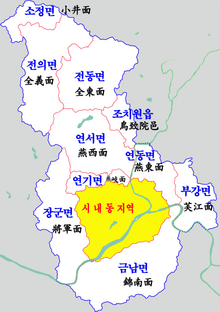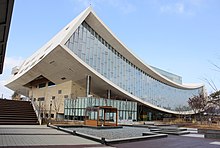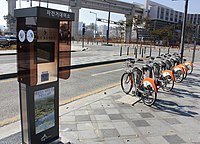Yeongi County
Sejong was founded in 2007 as the new planned capital of South Korea from many parts of the South Chungcheong Province and some parts of North Chungcheong Province to ease congestion in South Korea's current capital and largest city, Seoul, and encourage investment in the country's central region. Since 2012, the government of South Korea has relocated numerous ministries and agencies to Sejong, but many still reside in other cities, primarily Seoul, where the National Assembly and many important government bodies remain.
Sejong has a population of 351,007 as of 2020 and covers a geographic area of 465.23 km (179.63 sq mi), making it the least-populous and smallest first-level administrative division in South Korea. Sejong is located in the west-central Hoseo region, bordering South Chungcheong to the west, Daejeon to the south, and North Chungcheong to the east.
The construction of the city is expected to be completed in 2030, at which time 500,000 people are expected to live there.
Name
Sejong was named in honor of King Sejong the Great, the fourth king of the Joseon Dynasty and creator of the Korean alphabet, Hangul. The city was formed by combining Yeongi County, the county of South Chungcheong Province from which the majority of the city's territory was ceded, and other counties.
History





In 2003, then-President Roh Moo-hyun sought to relocate the national capital of South Korea from the metropolitan city of Seoul to a new multifunctional administrative city in the center of the country. The goal was to reduce the influence and dominance of Seoul on national governance and economics, whilst promoting the regional development of other areas of the country. According to the former Interior Minister Maeng Hyung-gyu in 2012, "Sejong is a symbol of the country's efforts toward more balanced regional development," helping to decongest Seoul and spur investment in the country's central region.
In October 2004, the Constitutional Court dealt a setback to President Roh's plans, ruling that the capital must remain in Seoul in response to a complaint filed by the main opposition, the conservative Grand National Party. As such, the Roh administration was forced to modify the project to relocate the majority of government ministries and institutions to Sejong, which would become a special administrative city instead of a new capital. The revised plan was approved by the National Assembly in March 2005. Challenges to the new plan were rejected by the Constitutional Court in November 2005.
When the Grand National Party retook the presidential office in 2008, then-President Lee Myung-bak opposed the idea of moving government agencies, claiming that it would hurt Seoul's global competitiveness and result in inefficiency. Following Lee's directions, plans were made to make Sejong an industrial, science and education hub instead. This plan was opposed by many, including Roh's allies and some members of the ruling Grand National Party, including Lee's arch-rival and eventual successor, Park Geun-hye. Defeat in the mid-2010 local elections forced Lee to present his proposal to the National Assembly where it was voted down.
In December 2008, construction for the Sejong Government Complex started. After level 1 of the construction was completed in November 2012, level 2 was finished in November 2013, and finished construction in November 2014.
In July 2012, Sejong Special Self-Governing City was created by combining all of Yeongi County, three townships of Gongju and one township of Cheongwon County. Jochiwon was the main city within Yeongi.
In April 2013, the city government of Putrajaya, Malaysia signed a letter of intent (LOI) with the government of Sejong City to mark cooperation between the two planned capitals.
As of 2019, 12 ministries were relocated to the city. As such, only 5 ministries continue to remain in Seoul; the Ministry of Foreign Affairs, Ministry of Unification, Ministry of Justice, Ministry of National Defense, and Ministry of Gender Equality and Family.
Sejong was specifically designed to be a "smart city", and is sometimes referred to as Sejong smart city. It is the leading smart city in Korea, and is often held up as the standard for other cities experimenting with the development of smart city infrastructure.
By 2019, there was disagreement among experts as to whether Sejong has "lived up to expectations". Sejong uses its new development to market itself as an alternative to Seoul, offering luxury living at a fraction of the cost. It boasts shiny state-of-the-art condominiums, ample public green space and smart and sustainable city tech, like automated trash collection and zero-waste food disposal, electric car charging and sharing stations, solar-powered buildings, interactive digital signage, closed-circuit television security and fine dust emergency alerts. It has sparked criticism that the new city is not only too lackluster to draw residents away from Seoul, but also difficult to access and poorly designed"
Geography
Sejong is surrounded by the two provinces of South and North Chungcheong, as well as the metropolitan city of Daejeon. It is about 121 kilometres (75 mi) south from Seoul.
Climate
Sejong City has a humid continental climate (Köppen: Dwa), but can be considered a borderline humid subtropical climate (Köppen: Cwa) using the −3 °C (27 °F) isotherm.
| Climate data for Yeonseo-myeon, Sejong City (1993–2020 normals) | |||||||||||||
|---|---|---|---|---|---|---|---|---|---|---|---|---|---|
| Month | Jan | Feb | Mar | Apr | May | Jun | Jul | Aug | Sep | Oct | Nov | Dec | Year |
| Mean daily maximum °C (°F) | 3.8 (38.8) |
6.9 (44.4) |
13.1 (55.6) |
19.6 (67.3) |
24.6 (76.3) |
28.0 (82.4) |
29.4 (84.9) |
30.1 (86.2) |
26.2 (79.2) |
20.8 (69.4) |
13.2 (55.8) |
5.6 (42.1) |
18.4 (65.1) |
| Daily mean °C (°F) | −2.7 (27.1) |
−0.1 (31.8) |
5.5 (41.9) |
11.7 (53.1) |
17.4 (63.3) |
21.7 (71.1) |
24.7 (76.5) |
24.9 (76.8) |
19.8 (67.6) |
13.0 (55.4) |
6.1 (43.0) |
−0.7 (30.7) |
11.8 (53.2) |
| Mean daily minimum °C (°F) | −7.8 (18.0) |
−5.4 (22.3) |
−0.8 (30.6) |
5.1 (41.2) |
11.2 (52.2) |
16.7 (62.1) |
21.0 (69.8) |
21.1 (70.0) |
15.4 (59.7) |
7.3 (45.1) |
0.8 (33.4) |
−5.6 (21.9) |
6.6 (43.9) |
| Average precipitation mm (inches) | 22.6 (0.89) |
31.4 (1.24) |
42.4 (1.67) |
76.6 (3.02) |
86.5 (3.41) |
132.5 (5.22) |
284.9 (11.22) |
260.3 (10.25) |
141.2 (5.56) |
58.4 (2.30) |
45.3 (1.78) |
22.8 (0.90) |
1,204.9 (47.44) |
| Average precipitation days (≥ 0.1 mm) | 5.2 | 5.0 | 6.3 | 7.0 | 6.9 | 7.7 | 13.2 | 12.7 | 7.8 | 5.2 | 7.3 | 6.0 | 90.3 |
| Source: Korea Meteorological Administration | |||||||||||||
Administrative divisions
Sejong is divided into 14 haengjeong-dong (administrative neighborhoods), 1 eup (town) and 9 myeon (townships). The 10 haengjeong-dong and Jochiwon-eup is the city main urban centre.








